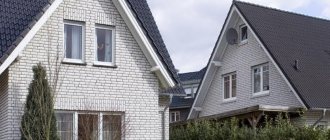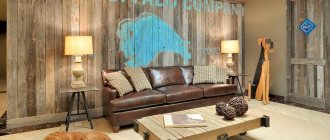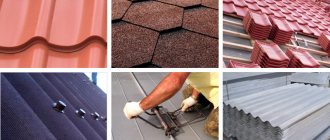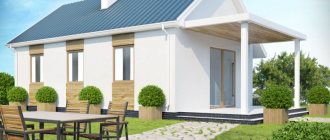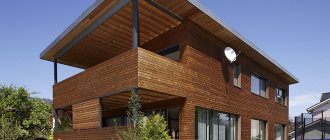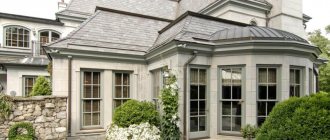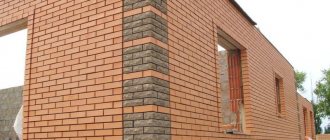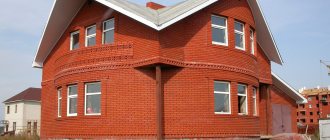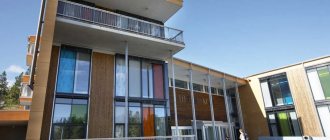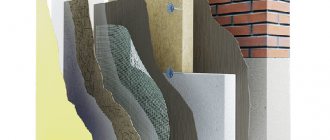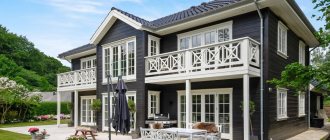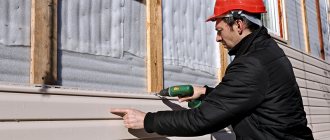The finishing of the facade is not thought out after construction is completed, but at the design stage of the house. It requires specific materials taking into account the parameters of a private cottage. First, let's define what the facade of a house is and what function it performs. Façade means “face” in Italian. This refers to the outer part of the building, its walls and all related architectural details and decoration . In other words, the facade is the exterior.
At its core, a façade – what is it? This is the appearance of the building, which must correspond to national traditions, fit organically into the landscape of the site, and be in harmony with the rest of the buildings on it.
The modern building materials market offers a huge range. When choosing materials for cladding, it is necessary to consider the following factors:
- the building must have an aesthetic appearance that is in harmony with nature and corresponds to the preferences of the owner;
- The finishing of the facade of a private house plays a protective role, so the task of the materials includes additional insulation, sound insulation, and preservation of the building from moisture, UV radiation and other climatic influences.
Let's consider what can be used to decorate the facade of a house, what types of facing materials meet the requirements of these factors and give the home durability, comfort and an attractive appearance.
Facade finishing: specifics and varieties
The facade is as important a part of the structure as the roof or foundation. Facade finishing technologies are constantly evolving. For an apartment building, private house or country house, there are always optimal ways to clad the walls on the outside. The market offers many solutions for finishing external walls. You can select them yourself or with an experienced specialist. When choosing finishing materials, you need to consider several important points. The building should fit harmoniously into the local area and look attractive. And the material should not only play the role of decoration, but also insulate the object. The load-bearing structures of a construction site must be reliably protected from negative external influences. Methods for finishing the facades of private houses should be chosen thoughtfully and consciously by experienced craftsmen. Combined types of facade cladding remain popular.
Facade cassettes
Facade cassettes made of metal with a polymer coating are a godsend for cladding facades in a modern style. Neither precipitation, nor fungus, nor accidental mechanical impacts will cause any trace to such panels. A huge selection of standard sizes will allow you to create an incredible futuristic exterior that will stand out against the background of standard building facades. At the same time, the cost of cladding will remain loyal. However, you need to be careful when cutting these panels, as damage to the protective layer will lead to corrosion and repairs will be required. By the way, if the cassette gets a defect, it can be replaced with a new one without undertaking large-scale alterations.
Figure 9. Facade cassettes made of metal with a polymer coating - a godsend for cladding facades in a modern style.
Types of facade structures
Finishing the facade of a house is not an easy task, the execution of which must be trusted only to professionals. When choosing, you should take into account what the house is built from; the concept of organizing the cladding will depend on this.
Typically in the construction world, facade systems are divided into the following types:
- “Wet” - the device involves the use of a solution.
- “Dry” - installation is carried out using mechanical fasteners. This includes various fasteners.
If there is a gap between the external wall and the material, then the system is called a ventilated facade, the cladding of which creates all the conditions for free air circulation. A suspended ventilated façade can be insulated by selecting the optimal materials.
Functions of facade finishing
Decorating the walls outside is a necessary job, but creating a spectacular façade decoration is not easy. The use of various facing coatings makes it possible to achieve, when improving the appearance of a building, effects that improve its operational characteristics and living conditions inside the building. The outer cladding of a structure, when chosen correctly, allows you to:
- ensure protection of the walls of the structure from the destructive effects of environmental factors: moisture, temperature fluctuations;
- improve (in most cases) the level of thermal insulation of the structure, which significantly saves money on heating;
- create an additional soundproofing layer that prevents external noise from entering the home, which is especially important when located nearby noisy neighbors or highways;
- decorate the house efficiently and beautifully;
- increase the fire safety level of wooden buildings;
- maintain natural circulation of steam and air.
A superbly decorated house.
Insulation of the facade allows you to maintain a comfortable temperature even in the summer without the use of air conditioning systems.
The achieved diversity in design is incalculable. One example of harmonious decoration is shown in the photo below.
It is easier to properly clad a house and maintain the functional state of the created cladding than to repair load-bearing structures. Decoration is one of the main tasks when arranging a facade.
Modern materials for finishing the facades of private houses
Cladding the facades of houses with modern materials is a current service provided by many construction companies. The choice is always individual and depends on the personal preferences of home owners. You can choose and purchase any material to equip the facade of the building in such a way that it harmoniously combines with the roof of the building. It is best to purchase facing materials together with a specialist. Decorative finishing of the facade of a house is a complex task that must be approached seriously.
The most common types of finishing the facade of a private house:
- Plastering
- Natural stone (sandstone, granite, marble)
- Fake diamond
- Facing brick
- Porcelain tiles
- Facade tiles
- Decorative siding
- Fiber cement boards
- Sandwich panels
- Thermal panels
The following can also be used: flexible bitumen tiles, block house, timber.
Exterior decoration of the house with bark beetle
Where is it used?
The bark beetle is used for plastering the facades of houses and offices. Suitable for walls made of stone, brick, sandwich panels, concrete, foam and aerated concrete. It can be applied to any insulation: mineral wool, foam concrete, expanded polystyrene.
There are two types of bark beetle:
- Acrylic. Sold ready-made. Does not need painting.
- Cement-gypsum or mineral. Sold as a dry mixture. The mineral bark beetle must be painted with silicone-based paint. Otherwise, in 2-4 years not only the decorative layer will collapse, but also the base reinforcing layer.
Depending on the application technique, the bark beetle looks different (photo No. 6)
pros
- Weather resistance. The plaster can withstand temperatures from - 55°C to + 60°C.
- Resistance to mechanical stress. The bark beetle can withstand impacts from hail, water flow, and light tapping.
- Texture, due to which you can hide uneven walls. Also, due to the pattern on the bark beetle, cracks are less visible.
- Easy to apply. If desired, you can plaster the walls yourself.
- Large selection of colors.
Minuses
- It quickly becomes clogged with dust. It needs to be washed at least once a year.
- If a chip has formed, it is difficult to restore the bark beetle without it being noticeable.
- If you do not prepare the walls for application or violate the technology, there is a risk of swelling and peeling of the plaster.
Plastering
Decorative plaster is a common method of decorating buildings.
The varieties differ in the characteristics and types of finished surface:
- Mineral plaster is thin-layered, but durable and reliable. In terms of cost, it is inferior to other analogues, so you can purchase it in any quantity. Before finishing work begins, the plaster is dissolved in the required amount of water. Ready-made mixtures are much more expensive and must be used immediately after opening the package. Mineral plaster is resistant to ultraviolet radiation and the formation of mold and mildew. The plaster is applied to a previously prepared concrete surface.
- Acrylic plaster is a ready-made mixture of acrylic and water. It is plastic and perfectly protects walls from temperature changes. The composition is elastic, and therefore, even when the building shrinks, the formation of cracks is excluded. It is also durable, according to the manufacturers, it can last about 18 years, and is also characterized by increased resistance to weather conditions. Facing with such plaster will retain an attractive, neat appearance for a long time.
- Silicone plaster has the form of a mixture through which you can create a surface of any texture thanks to particles of quartz sand. The composition of such plaster is very similar to the composition of mineral mixtures, but it is based on liquid potassium glass. Allows you to create interesting, unique designs.
- Silicate plaster is the most durable option; its service life can reach thirty years. Elastic and resistant to temperature fluctuations. Among the disadvantages, it is worth noting the need to quickly apply the mixture.
Facade plaster of any type is distinguished by a variety of colors.
Advantages:
- Attractiveness and aesthetics of external walls
- Wide range from which you can choose the right solution
- Possibility of painting in any suitable color
- UV immunity
- Excellent insulation
- Good strength
- Simple and quick installation
- Affordable cost
Among the disadvantages is the likelihood of cracks and stains. All the negative consequences that may arise are the result of low-quality installation, so you can only trust plastering to competent craftsmen. Plaster is optimal for cladding a house made of aerated concrete. The cost of plastering per m2 may vary for each construction company.
Facade plaster for external cladding
Facade plaster for cladding buildings has a different composition, texture and binding element. Components for plaster are selected depending on climatic conditions, frequency of precipitation and type of primer.
Before applying plaster, the wall must be prepared using a sandblaster to clean the surfaces or a wire brush. All irregularities are removed with a chisel, and in the presence of greasy stains, the contamination is treated with a solvent
Applying plaster to a substrate that tends to expand/contract with changes in humidity levels requires precautions to be taken to prevent cracks in the finish. Therefore, a plastic binding element is added to the solution.
In this regard, in the process of preparing components for the solution, it is necessary to familiarize yourself with the characteristics of the finish and the climatic conditions of the region. Then properly selected plaster will last for several decades.
In addition, facade plaster when facing a house has the following advantages:
- protects walls from precipitation and mechanical influences;
- gives the building a unique look, as it can be applied in the form of decorative textures of various colors;
- has high adhesion, elasticity and safe composition;
- resistant to UV rays and temperature changes.
A high-quality composition applied to the walls of a building has many advantages. But if during the mixing process the proportions of raw materials were not observed or second-rate materials were used, then in the first season the plaster will partially fall behind the wall, crumble, and the façade of the building will have to be renewed again.
If you decide to insulate your house before performing façade cladding, pay attention to the technologically advanced and practically waterproof Penoplex. Our recommended article will introduce you to its characteristics, varieties and advantages of use.
A natural stone
Cladding a building with natural stone is a popular trend. Stone is unrivaled among other façade materials. In terms of decorative qualities - a leader. Exterior decoration of the facade of a house with natural stone cannot be cheap. Stone is quite expensive, so many owners of country real estate only partially cover the façade with it or combine it. Decorating the facade exclusively with natural stone will be expensive, but such a decision will pay off,
because it is durable and has its advantages:
- Durable and practical. Once you invest in stone cladding, you can forget about repairs for a long time.
- Aesthetics and attractiveness. A stone facade always looks luxurious and expensive.
- Eco-friendly option. Does not harm the environment.
- Moisture resistant
- Fire resistant
- UV resistant
- The options for finishing the facade in this way are endless. With the help of a competent designer, you can create a unique exterior.
Among the disadvantages, we highlight the large mass of natural stone and the high price. Granite stone, sandstone, marble or dolomite remain in demand. Granite finishing will look very elegant. Granite will add monumentality to the structure. Sandstone is also often used for cladding. Stonework looks expensive and elite, emphasizing individual style. Ventilated facades for stone have a long service life. It is better to lay stone in several stages. Buying material in Moscow is not difficult. It is definitely worth considering how harmonious the future façade and roof of the house will look.
Plastering and painting
Among the “wet” methods of finishing the outside walls of a house, a popular option is plaster for bases made of brick, monolith, cinder block, and aerated concrete. It is applied directly to the rough surface, or on top of a layer of insulation. It is also common to use it for interior decoration, but the composition is different. Facade varieties are widely used in rooms with high humidity levels.
The traditional option is mixtures based on sand and cement. New formulations are becoming increasingly common:
- silicate;
- acrylic;
- polymer;
- silicone.
For external work, only moisture-resistant mixtures are used. Compositions based on gypsum or clay are not suitable.
Based on the appearance it creates on the finished surface, plaster is divided into textured and smooth.
The first one is well suited for both professionals and beginners, because it makes it easier to hide minor flaws.
Creating a smooth facade for subsequent painting is a complex, highly skilled job.
The main advantages of plaster coating are as follows:
- relative cheapness compared to other materials used to decorate the exterior walls of buildings;
- a wide variety of colors, application options (created textures, patterns) allows you to implement various design solutions;
- the simplest design methods are available to beginners in construction;
- combines well with other finishing coatings;
- plaster solutions are easily applied to the insulation.
The disadvantages are:
- relatively short operating time (about 20 years) compared to analogues;
- Often after repairs its traces remain visible.
The technology of working with decorative compositions differs in obtaining different effects on the surface. The result of finishing (“bark beetle”) is shown in the photo below.
Plaster "Bark beetle"
Using paint, they decorate surfaces made of various materials: plastered, brick, stone, wood, panel. The created layer protects from moisture, dust, and solar radiation.
When applying paint, the surface is first prepared accordingly.
For coloring, compositions are used based on the type of base.
The created plaster layer closes cracks, joints, and levels the surface. At the same time, sound and heat insulation is improved. The coating protects the base well.
Facade cladding with artificial stone
This is a budget solution for inexpensive but high-quality cladding. The structure of the stone and its pattern create a unique design. This material is in great demand. Thanks to innovative technologies, manufacturers managed to create an artificial stone, which in its characteristics is in no way inferior to its natural counterpart. This option has gained great popularity among residential building owners, builders and designers.
What are its advantages:
- Light weight, installation requires a small amount of solution
- The stones are light in weight
- Does not cause cracks
- Durable and durable
- Excellent washability
- Does not have a negative impact on the environment.
Installation of this type of stone is simple and carried out quickly. Its cost is affordable; the material is in great demand in Moscow.
Facing brick
Among the common materials for the external walls of residential buildings is brick. Decorative brick is widely used. Brick cladding is suitable for buildings made of aerated concrete.
This type of material is divided into types:
- Clinker brick. Quite an expensive material, which is made from special types of clay. During the firing process, the clay is completely baked, which ensures the highest strength. Sometimes natural dyes are added to the resulting mass. Clinker bricks are the best of their kind. Its advantages are obvious: excellent strength, long service life, resistance to low temperatures. This brick exhibits absolute resistance to chemicals, is not afraid of solar radiation, and is also completely environmentally friendly. No specific care is needed for clinker bricks. Among the significant disadvantages are the high price and rather labor-intensive installation, which requires experience and skill. An alternative option is clinker tiles. It is made according to approximately the same principle; it is distinguished by a variety of color options and relief. Cladding the façade of a private house with clinker tiles is a budget-friendly and durable option. Clinker tiles are an unusual and non-standard material that is used for various structures, for frame houses. You can buy clinker at specialized retail outlets. A good analogue to brick are facing blocks. They are made from expanded clay concrete. The blocks have low moisture permeability and excellent air permeability. The large size of the blocks significantly reduces the load on the foundation, and they are also easy to lay. Installation is used: flexible connections “seam to seam” and flexible connections “seam to body”.
- Ceramic brick is distinguished by a wide variety of shades. Among the advantages, we highlight durability, absolute environmental friendliness, and soundproofing properties. Ceramic brick also exhibits good resistance to temperature changes. The price is much lower than analogues. The most significant of the disadvantages is the possibility of destruction, which can occur if errors are made in the choice of solution. The geometric shape of parts is not always ideal. The material is not frost resistant. Therefore, it is not suitable for buildings located in certain climatic regions where winters are harsh. The unusual brick facade looks expensive and rich.
- Hyperpressed brick - produced by semi-dry pressing of cement, shell rock and other special additives. Visually similar to the previous type of brick, but has more advantages: excellent geometric shape, strength, frost resistance and ease of processing. Disadvantages: impressive weight and tendency to darken. Cladding the facade of a house with brick is a common option among modern owners of country real estate. It is not necessary to cover every m2 with brick; you can combine it with various materials. Relatively cheap option.
- Sand-lime brick - it is made by autoclaving. The cheapest type of brick. The advantages are the following: increased strength, geometry accuracy, environmental safety, good sound insulation properties. Cons: not very aesthetically pleasing, poor thermal insulation performance and a fairly high level of water absorption. Sand-lime brick is relatively cheap.
Brick cladding is suitable for almost all building structures. Porcelain stoneware finishing can be combined and include other elements. It is very important to choose a harmonious color so that the facade matches the roof.
Types of cladding and finishing
The range of construction stores and markets is really huge. Each material has distinctive features and is not suitable for all substrates. Therefore, when choosing an option for yourself, consider:
- Base compatible.
- Material service life.
- Resistance to external negative influences (temperature changes, mechanical, chemical and biological influences, ultraviolet radiation).
- Simplicity and speed of installation.
- Method of care.
- Aesthetic appearance.
- The cost of products and the cost of performing work if the cladding is carried out by hired workers.
If you adhere to such criteria, the result will not only please you for many years, but the house will also become warmer and more comfortable.
Natural stone and its imitation
You can choose natural and artificial stone as a finishing material for the exterior walls of your home. The decoration emphasizes the style and taste of the home owner. Both options have excellent technical characteristics:
- durability;
- resistance to temperature fluctuations;
- excellent moisture barrier;
- UV resistant;
- rodents, fungi and mold cannot damage the material;
- difficult to damage mechanically;
- environmentally friendly material, both natural and artificial.
But there are several differences between these two options. Natural stone is very expensive, and it weighs a lot. Therefore, not every new building can withstand this load. Therefore, natural stone is either replaced with an artificial analogue, which is much lighter and slightly cheaper. Or they can be combined with other types of finishing, such as plaster.
The materials and installation method differ. Natural stone, for example shell rock, is in most cases glued to the facade. But for such finishing, the master must have extensive experience in order to correctly and efficiently install all the details.
Artificial stone can be mounted either with glue or with the help of mechanical fasteners, like a ventilated facade. Most often, the analogue is produced in the form of slabs, so working with them is much easier.
Brick
One of the most popular options for finishing the facade is facing brick. This material also has its own varieties. Thus, buyers are provided with:
- silicate;
- hyper-pressed;
- clinker;
- ceramic brick.
Each of these options has its own distinctive characteristics. But some advantages will be common to all options:
- Duration of service.
- Resistance to any negative influences.
- Heat and sound insulation properties.
- Variety of colors and textures. There are glossy and textured options on sale.
- Possibility to purchase bricks of different shapes.
The only thing that spoils the picture is the cost of materials and the complexity of constructing the cladding. A beginner will not be able to cope with the task. The master knows the peculiarities of laying bricks. Moreover, the finishing process takes quite a long time, even if the work is carried out by a professional team.
Plaster
This option is also one of the popular and long-known methods of finishing the facade. Now there are ready-made compositions that are much easier and faster to work with, because you don’t need to measure out a certain amount of each component.
Moreover, the plasters differ in composition, so you can find a suitable option for both a wooden house and a foam block base. The composition of plaster mixtures is:
- mineral;
- silicate;
- acrylic;
- silicone.
If you properly prepare the surface and complete all the steps, the plastered facade has the following properties:
- Insulated and isolated from extraneous external noise.
- Repels moisture.
- It looks attractive, and using a textured option is also original.
- Allows steam to escape from interior spaces.
- Quite durable and can withstand light mechanical loads.
- Resistant to changes in ambient temperatures.
Plastering can be done with your own hands. Although for beginners it will take a little longer than for a professional. The cost of different compositions varies within affordable ranges, so everyone will find an option for themselves. But if all the work is done incorrectly, the following problems will arise:
- appearance of stains on the facade;
- peeling of finish;
- occurrence of cracks.
Therefore, before starting work, read the instructions that the manufacturer indicates on the packaging or read literature on the Internet. If you are unsure of your abilities, entrust the work to a master.
Siding
This is one of the modern popular facing materials. The cost of such cladding is low. The material is quick and easy to install, it is lightweight and attractive. Therefore, it can be used to update an old dacha or garage. But siding is also suitable for residential buildings.
The panels are installed on the frame like a ventilated facade. Depending on the material from which the siding is made, there are several options:
- Metal.
- Wooden - under a log, beam or board (planken).
- Vinyl.
- Cement.
Panels
This category of finishing materials is more diverse than, for example, brick or plaster. Moreover, if the previous versions had approximately the same characteristics. In this case, the materials differ greatly in structure and properties. Therefore, we will consider each panel separately
Metal with polymer coating
Such panels are made from galvanized steel sheets, therefore they are light in weight, and therefore suitable for reconstructing the facades of old buildings. Metal panels are installed like a ventilated facade, so there is always room for heat-insulating material.
Manufacturers create different variations of panels. The color of the parts is also varied. There are imitations of wood and stone, which increases the popularity of the material. True, metal panels are most often used for cladding:
- car washes and gas stations;
- office and administrative buildings;
- industrial buildings.
Vinyl trim panels
In private construction, vinyl siding is chosen for facade cladding. This option has several advantages:
- Light weight.
- Large selection of colors. But professional craftsmen recommend choosing pastel and light shades. Because under the influence of ultraviolet radiation, even the highest quality siding loses color over time. On panels of light shades this is not so noticeable.
- Simplicity and speed of installation.
- Easy care. The panels can be cleaned with running water or even rain.
- Affordable price.
But with siding everything is not so simple. Although it installs quickly, you must follow all the recommendations. Vinyl panels have the disadvantage of changing linear dimensions under the influence of both high and low temperatures. Therefore, when fixing the part, the fasteners are not fixed tightly, but leave a gap of 1–2 mm.
Double-layer thermal panels
This option combines two necessary attributes for facade finishing:
- Insulation – to maintain the required temperature in the room of the house.
- Finishing material - for updating and decorating the facade.
The two components are firmly glued together, so there is no need to first create a thermal insulation layer and then attach the cladding. This significantly speeds up the process of cladding the facade.
Various materials are used as a decorative layer. Therefore, you can choose cladding of any color and texture. For those who love naturalness, imitation of natural stone or wood is suitable, and for those who are fans of the classics, you can choose brickwork.
The panels are fixed directly to the facade using adhesive for exterior use with additional mechanical fastening. Even a beginner can handle the installation process. Moreover, thermal panels can be installed at any time of the year.
Facade facing sandwich panels
We can say that this is a finishing option, a type of thermal panels. The difference between sandwich panels is the presence of two rigid layers, between which the insulation is located. All structural elements are glued together. For this, hot pressing is used. The advantages of the panels include:
- heat and sound insulation;
- resistance to high humidity;
- low weight, both individual parts and the entire structure;
- speed of installation;
- unpretentious maintenance of the facade;
- Fire safety.
Fiber cement facade panels
A finish is created based on cement mortar, similar to plaster. Cellulose or glass fiber, which is called fiber, is added to it. Therefore, the panels acquired the name fiber cement. Although the amount of fibers is small, only 10%, it is enough to make the panels quite rigid.
The undeniable advantages of fiber cement panels include:
- Environmental cleanliness.
- Strength.
- Moisture-repellent properties.
- Fire safety.
- Quick installation, as panels are available in large sizes.
- Lightweight cladding due to cellulose fibers.
Manufacturers create options with grooves along the edges so that the façade is monolithic. And there are also regular panels. Mono installation using the frame method.
Decorative tiles
Tiles are also produced for cladding facades. It differs in size, material used to create it and texture. Facade tiles differ from panels only in size. In all other respects, that is, technical characteristics, the tile duplicates.
Ceramic tiles have exactly the same properties as ceramic bricks, only to create the finishing there is no need to build an additional wall or strengthen the foundation. The tiles are easily glued to the outside of the walls and protect the structure from negative influences.
More recently, so-called flexible tiles have appeared on sale. This finishing option easily adapts to angles. There is no need to buy special corner parts, which can cost many times more. The element is simply bent to the desired angle and that’s it.
External facade finishing with porcelain stoneware
Porcelain tiles are durable and reliable, suitable for hanging facades. Thanks to its unique texture, it looks very expensive and presentable. This is reliable protection for the walls of a residential building.
Advantages:
- Durability and strength
- Resistant even to extreme temperature fluctuations
- Original and interesting appearance
- Wide variety of colors with imitation of expensive materials
There is porcelain tile that imitates stone quite well. Available in matte, polished or polished form. Among the obvious disadvantages are considerable weight, high price and the need to attract professional specialists for cladding. The design features of the roof should be taken into account. The roof and facade should look harmonious.
No. 4. Porcelain tiles for facade
Porcelain stoneware, produced from clay, quartz sand, feldspars and water by semi-dry pressing, is one of the most durable materials for finishing the facade of a private house, and in terms of performance properties it is almost
and is not inferior to stone.
For cladding a private house, porcelain tiles with a thickness of at least 12 mm, and preferably 14-16 mm, are suitable.
Advantages :
- durability and strength , resistance to abrasion and mechanical damage;
- absolute moisture resistance . Porcelain tiles do not absorb moisture and are highly frost-resistant;
- resistance to extreme temperatures and temperature changes;
- maintaining the original appearance throughout the entire period of operation;
- great variety , the presence of many shades and textures, the ability to imitate stone, wood and other noble materials. Matte, polished (with a waxy sheen), glazed, polished, semi-polished, structured and mosaic porcelain tiles are available, so there is plenty to choose from.
Flaws:
- heavy weight;
- high price;
- specific installation . Due to its weight and low hygroscopicity, it will not be possible to use cement mortar for installing porcelain tiles - you will need either special glue or a metal frame.
Cladding the facade of the house with ceramic tiles
Among the options for cladding the facade of a house, tiles deserve special attention. This is a fairly common and inexpensive cladding method.
Let's consider the advantages:
- Long-lasting operation
- A wide range from which you can choose the desired option
- No deformation
- Not susceptible to sun fading
- Variety of colors and textures
- Options with imitation of expensive materials
- Fairly light weight
Finishing the facade with brick tiles is a popular trend among owners of mansions. Being environmentally friendly and having an original appearance, the tiles perfectly transform the appearance and provide insulation of the house. When installed correctly, the tiles will reliably protect the building from atmospheric influences and give it a well-groomed and expensive look. It should be taken into account that tiles are fragile, so work with them should be carried out by trained, experienced specialists.
Wooden materials for cladding
Wood is the only material that has good vapor permeability. Wooden products can be mounted on a wall made of any material, but they work best in the cladding of a wooden house. Any thermal insulation material can be used.
Natural moisture transfer will not allow steam and condensation to accumulate on wood surfaces; the wall will always be dry, which will prevent its destruction. However, direct contact of wall materials with cladding lumber should be excluded. There must be a ventilation gap between them.
Wooden products for exterior decoration include:
- Block house . The block house building looks like a house built from rounded logs.
- Imitation of timber . In this case, the material imitates planed timber.
- Lining . A more affordable wooden material for cladding the facade of a house.
- Dies, shingles, shindles and planks . Small boards of wood are suitable for decorating the facade of a building for a hardworking owner.
Installation of wooden cladding is carried out on the sheathing. Basalt wool is laid in the spaces between the beams, after which the wooden sheathing is attached.
The most affordable cladding option is a façade made of planed boards. Stuffed according to the principle of a cone and with proper processing, the democratic cladding will become the most durable
The advantages of wooden cladding include its environmental friendliness, excellent heat and sound insulation. The walls of the building, under wooden cladding, are protected from mechanical influences, precipitation and temperature changes.
Disadvantages include flammability and the presence of natural defects, due to which a lot of residues are formed during primary and subsequent processing.
With proper annual care of the wood, the facade will last for many years. But if there is no possibility and desire to constantly treat the surface, use other materials, since wood in its natural state is susceptible to rotting, pests and darkening.
Finishing the facade of a private house: decorative siding
Finishing the facade of a house with siding is a wonderful way to beautifully improve your home. Used for finishing facades, balconies and loggias. Unusual beautiful siding can decorate both a cottage and a large mansion. Siding is a budget material for facades; it has excellent decorative qualities. Before purchasing, you need to decide how many m2 you will need. This material is durable and will last for years. Often used for finishing aerated concrete structures. We also highlight good heat and sound insulation qualities. Covering the facade with siding can transform the appearance of even a house that was built a long time ago. This is a common type among other facade materials. The key step in the cladding process is the installation of the frame.
Types of siding:
- Vinyl siding is a budget-friendly and beautiful-looking material. Manufacturers offer a lot of original options with imitation timber, stone, and logs. Available in a variety of colors. Due to its ease, it can be installed even without the involvement of a specialist. Siding of this type can radically transform a country house and give it an incredibly sophisticated look. Inexpensive siding of this type has some disadvantages, including the likelihood of cracks forming in severe frost, and in hot weather the panels become softer, which sometimes leads to deformation. In private construction, this type is used most often. Often the advantages include resistance to mechanical damage, but it must be taken into account that a strong blow can damage the integrity of the siding. And damaged elements are difficult to repair. The method is suitable for cladding a frame house.
- Metal siding. Made from aluminum or steel. The metal must be coated with a special layer of primer and polymers. Aluminum siding is an expensive option, which is why it is rarely used in private construction. More often they resort to steel sheets with zinc protection. The material is strong and durable, exhibits excellent temperature resistance and is non-flammable. Any vagaries of the weather are not scary, we also note the high aesthetics and attractiveness. Installation of metal siding is absolutely simple. In addition, it is resistant to rotting. Does not lose color under the influence of ultraviolet radiation. Cons: probable rust formation and high price. Metal siding, even despite its shortcomings, is in demand and popular.
- Wood siding – wood has not lost its popularity over the centuries. Modern technologies make it possible to work with durable and reliable wooden panels that demonstrate excellent performance properties. The panels are made from wood pre-treated with antiseptic compounds. Wood siding is absolutely safe and environmentally friendly. Facades designed in this way look natural and cozy. Cons: the need for periodic treatment with special protective compounds, mold formation and insect attacks. The cost of wood siding is relatively high.
- Cement siding is produced in the following way: cement and cellulose fibers are mixed and pressed. This is a highly durable, weather-resistant material. Disadvantages: large mass, labor-intensive installation and rather high price.
Finishing the facades of houses with modern materials should be carried out by professional specialists who know how to work competently with a certain material.
Types of facade finishing: fiber cement boards
Fiber cement boards. They do not contain harmful toxic compounds or hazardous impurities. The slabs are often used to construct suspended ventilated facades in frame buildings. Such elements can be used as a decorative coating outside or in the process of interior decoration. The material is non-flammable, provides sound insulation and is resistant to atmospheric influences. Manufacturers guarantee a long service life of 50 years. Fiber cement boards are perfect for use in private construction or the construction of high-rise buildings. Thanks to its special structure, the material is breathable, thereby creating a favorable microclimate in the premises. The plates are quite strong and reliable.
What is finishing a house with siding: types of material
Siding resembles clapboard. The only difference between them is that one material is attached to the wall surface with an overlap, and the second - using locking joints. Most often, the exterior of a house is finished with siding made of aluminum, although vinyl and wood panels are also considered in demand.
Some options are distinguished by the presence of a polymer coating of various tones, but the greatest demand is for panels that imitate the pattern of wood or stone. You can often find trim on the outside of a house that imitates timber, which can only be distinguished from real wood upon closer inspection. Due to the fact that each panel is laid on the previous one at a large slope, moisture flows freely from the surface without penetrating onto the main wall.
Vinyl, wood and aluminum siding are used to decorate houses.
On a note! Siding is available in single or double panels. To make the house look more attractive, it is recommended to use several different textures for finishing: the base can be finished with stone-like siding, and the rest with wood-like siding. In the photo, houses covered with brick siding cannot be distinguished from ordinary brick trim.
As for the prices of finishing a house with siding on the outside, it is worth noting that using this material you can save a lot of money, because siding is cheaper than natural materials and is much easier to install. At the same time, the panels have a long service life. Another advantage of siding is the ability to use it for cladding buildings made of any material.
Before decorating a house with siding, you should familiarize yourself with the main types of this material. Vinyl sheets are made from high-tech polyvinyl chloride, which can be used at any temperature. The panels are easy to cut, which allows you to create the ideal appearance of the facade, even if there are protrusions and other decorative elements on the base.
Siding is the most economical cladding option, since it is not expensive, and its installation is quite simple.
Vinyl siding consists of lamellas, the thickness of which is 1-1.2 cm, and the width is 20-25 cm. It is mounted on a metal or wooden sheathing. To leave room for possible movement of the lamella, it is not recommended to screw in the self-tapping screw with great force until it stops; it would be better if a small gap remains. To cover the lower part of the building, it is recommended to take not the usual, but the basement type of siding, which is thicker.
The main advantages of purchasing vinyl siding include:
- easy installation on buildings of any shape;
- low cost of panels;
- wide temperature range at which installation can be carried out from -5 to +40 °C.
Among the disadvantages is rapid fading under the influence of ultraviolet rays, so preference should be given to light-colored panels. Installation should not be carried out at non-recommended temperatures: if it is too cold, the siding sheets may crack when cutting, and in extreme heat the sheets may bend.
Finishing house facades with modern materials: sandwich panels
For a long time, sandwich panels were not used in our country. But today the situation has changed dramatically. Among other alternative options, sidings and stones, panels took an honorable leading place. This material is multilayer, it consists of several layers: metal and insulation. The two layers are connected to each other using hot pressing. Sandwich panels look great, the material is lightweight and non-flammable. It is also worth mentioning the excellent soundproofing characteristics. With proper installation, the panels will last a long time. Insulation and high aesthetic qualities are ensured. Sandwich panels are also used to insulate balconies. In combination with plastic, PVC panels provide maximum comfort in the room.
Among other types of cladding of house facades, panels remain in demand and popular; they are often used in the design of balconies and loggias. Facade panels can be purchased profitably in specialized stores in Moscow.
Decorating a home using facade panels
Where is it used?
Cladding panels are a particularly durable material. Suitable for all types of buildings. They can be used in any climate zone and are attached to any insulation. The panels retain impact resistance at temperatures from +50 to -60°C. The material is light and does not weigh down the building. They can be used either to cover the base or to cover the entire façade. Panels can be combined with siding.
Types of facade panels:
- Under the brick. "Alta-profile" produces several types of "brick" panels: antique brick, bassoon, clinker brick, brick. The panels are available in six colors.
- Under the tiles. The range includes 60 types of textures and colors: granite, stone, rocky stone, rubble stone and many others.
Cladding the base and the entire facade with “Stone” facade panels (photo No. 15)
Types of facade panels "Alta-Profile": video
pros
- Complies with GOST and international standards.
- Resistant to showers, hail, thunderstorms, snow.
- Suitable for cladding facades and plinths.
- When heated, they do not release toxic substances. The panels are suitable for private housing construction.
- Suitable for any climate zone.
- Can be mounted even on an uneven wall.
- Price from 1000 rubles per m2.
- Designed for 30 years of operation.
Thermal panels
They are one of the relatively new technologies that have managed to establish themselves as the most effective and reliable. The service life of thermal panels, according to the manufacturer’s forecasts, is up to 50 years. Among the obvious advantages, we note excellent vapor permeability, which allows the walls of the house to breathe and carry out normal moisture exchange. Also light weight, resistant to ultraviolet radiation and other natural factors. Thermal panels are installed in two ways: framed and frameless. The second method involves mounting the panel directly on the wall.
Wooden ventilated facade
The tree has always been famous for its unique properties. Wooden facades are extremely popular. This is the material that looks expensive and provides warmth and comfort. It should also be noted that it is possible to combine wood with stone or metal or glass. Natural material will organically fit into the exterior.
Among the main advantages we highlight:
- Optimal degree of strength and reliability
- Absolutely environmentally friendly
- Highest aesthetic characteristics
But it must be remembered that wood is a material that is highly flammable, so it is subject to special treatment. Also, wood is not resistant to the formation of mold and mildew; this problem can be dealt with using antiseptics. The façade of a wood-look house can be of two types: with and without insulation. Finishing the façade with wood will create an incredibly attractive and aesthetically pleasing home. And insulation with mineral wool will provide warmth and comfort in the room. Imitation of timber looks very natural and beautiful. A decorative board also looks elegant as an exterior finish. The board is an excellent alternative to natural wood cladding. Work on covering a house with boards is carried out quickly and simply.
Ceramic and concrete facade tiles
Currently, a fairly wide selection of tiles for facade cladding is offered. It can act either as a base or be used in combination with other materials. There are two types.
- Concrete. These are large panels with a texture that imitates natural stone or brick. Installation is carried out on a subsystem, for example, a sheathing. Due to their resistance to external influences, strength, and durability, concrete tiles are often purchased by private developers. The disadvantage is the large mass.
- Ceramic. In essence, this is the same porcelain stoneware, only a smaller slab. Most often, it is resorted to by private builders who do not have enough funds to cover the facade with clinker bricks. The tile looks superior to it, but costs significantly less. A facade made of ceramic tiles has the same advantages and disadvantages as those finished with porcelain stoneware. Bright design, high strength, ability to withstand aggressive environments and thermal influences outweigh the disadvantage of weak insulating properties. It is better to use tiles together with insulation. Laying is carried out using specialized mixtures that have adhesive properties.
